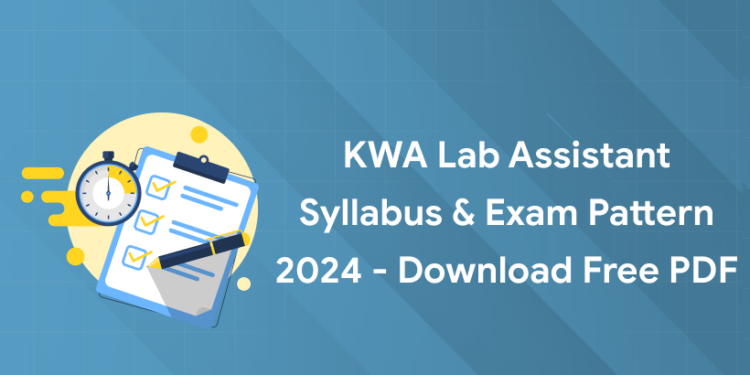Table of Contents
The Kerala Public Service Commission (KPSC) has recently announced the release of the Kerala Water Authority Lab Assistant Syllabus 2024 on its official website. This syllabus will be helpful for candidates who are preparing for the KWA Lab Assistant exam. It provides a detailed outline of the topics and concepts that will be covered in the exam. Eligible candidates can download the syllabus in PDF format from the KPSC website. It is recommended that candidates go through the syllabus thoroughly and plan their preparations accordingly to increase their chances of success in the exam. Download Kerala Water Authority Lab Assistant Syllabus 2024 now!
ENROLL NOW FOR KWA LAB ASSISTANT COACHING
KWA LAB ASSISTANT PREVIOUS YEAR QUESTION PAPER – FREE PDF
Kerala Water Authority Lab Assistant Syllabus 2024: Highlights
| Event | Details |
| Name of the Department | Kerala Water Authority |
| Name of post | Lab Assistant |
| Category Number | 431/2023 |
| Notification Period | October 30 to November 29, 2024 |
| Exam Date | July 13, 2024 |
| Method of appointment | Direct recruitment |
| Number of Questions | 100 |
| KWA Lab Assistant Exam Date Status | Announced |
| KWA Lab Assistant Admit Card | June 28, 2024 |
| Number of vacancies | 21 |
| Official website | www.https://keralapsc.gov.in/ |
KWA Lab ASSISTANT eXAM DATE 2024
Kerala PSC KWA Lab Assistant Syllabus & Exam Pattern 2024
1: Which Year First Assembly Election was held in Kerala?
The Kerala Public Service Commission (KPSC) has revealed the examination schedule for the Lab Assistant Recruitment 2024, category number 431/2023 for the Kerala Water Authority departments. The exam is set to take place on July 13, 2024, and the admit cards will be accessible for download starting June 28, 2024. Eligible applicants who have applied for the KWA Lab Assistant Recruitment 2024 can conveniently access the detailed syllabus for the examination via the Kerala PSC website, ensuring they are well-prepared for the challenges ahead.
The syllabus encompasses a comprehensive range of subjects, including biology, chemistry, physics, and practical laboratory techniques. Candidates can expect questions that test their knowledge of laboratory equipment handling, data analysis, and experimental methodologies.
The exam pattern typically comprises multiple-choice questions, practical demonstrations, and theoretical assessments to gauge candidates’ proficiency in both theoretical knowledge and practical skills. Moreover, the exam is structured to evaluate candidates’ problem-solving abilities and critical thinking skills essential for success in laboratory settings.
Enroll in Kerala's Top-rated Kerala PSC Coaching Program!
സർക്കാർ ജോലി എന്ന സ്വപ്നം ഇനി സ്വപ്നം മാത്രമല്ല! Join Entri's Kerala PSC Coaching Programs
Join Now!Kerala Water Authority Lab Assistant Syllabus 2024 PDF
Are you interested in excelling as a KWA Lab Assistant? Then, click on the link below to download the KWA Lab Assistant Syllabus 2024 in PDF format. The syllabus will provide you with comprehensive guidance on the skills and knowledge required to succeed in this field. Don’t miss out on this opportunity to enhance your career. Download the syllabus now!
Kerala Water Authority Lab Assistant Syllabus 2024: Detailed
Please check below for the detailed syllabus for KWA Lab Assistant Recruitment 2024
MODULE I – 10 Marks
BASIC LABORATORY TECHNIQUES
- Knowledge of Laboratory chemicals- hazard symbols, warning symbols, safety
precautions and storage of chemicals - Cleaning of glassware – general glass wares, new glass wares, blood- stained pipettes, slides, culture plates etc.
- Cleaning and disinfection of Disinfectants used and biosafety precautions in case of specimen spillage
- Bio- medical waste management -categories of bio-medical waste. Bio- medical waste – color coding, types of containers, collection, transport and disposal of biomedical waste.
- Basic first aid techniques for cuts & bruises, burn injury etc.
- Sample collection and processing – barcoding, safety precautions, processing of samples etc.
- Common Instruments used in laboratories – incubators, centrifuge, semi autoanalyzer, Colorimeter, Micropipettes etc
- Distillation and deionisation apparatus and use
- Laboratory management system
MODULE II- 13 Marks
BLOOD AND PHLEBOTOMY – 10 Marks
- Methods of blood collection –
o Capillary Puncture
o Arterial puncture and venous puncture
o Vacutainer – colour codes for vials - Sites of blood collection: Capillary and Venous.
- Anticoagulants used – advantages and disadvantages
- Identification of blood cells: Leishman’s staining procedure & identification
- Blood cell types: RBC, WBC, Platelets (Identifying characters and Normal Range)
HEMATOLOGY
- Heamocytometry Counting chamber : improved Neubauer
- Total cell counts:
- RBC, WBC, Platelet, Absolute Eosinophil count. (Diluting fluids, Normal value, Clinical Significance),
- Reticulocyte count : Clinical significance
- Hemoglobin estimation : Enumerate methods ,WHO recognized method : cyanmethhaemoglobin method, significance.
- PCV – Methods, Wintrobe ‘s method, Normal value clinical significance.
- ESR- Method (westergren’s method), Normal value, Clinical Significance.
- Test for coagulation:
- Bleeding time methods & Normal value of Duke’s method.
- Clotting time methods & Normal value of Capillary tube method
- Automation- Heamotology analyser, Haemogram, CBC – principle
BLOOD BANKING AND IMMUNO HAEMOTOLOGY – 3 Marks
- Blood group antigens and antibodies.
- Blood group system. (ABO and Rh system in detail,)
- Blood grouping techniques.
1. Cell grouping and Serum grouping.
2. Slide and tube method
Transfusion phlebotomy
- Donor screening, Donor selection criteria.
- Blood bank-Anticoagulants
- Compatibility testing and issue of blood.
- Cross matching-Minor and Major. Mention 3 phases.
MODULE III – 15 Marks
CLINICAL PATHOLOGY – 5 Marks
- Analysis of Urine, Sputum, Stool, Semen, CSF
- Types of sample, collection of sample, Physical, Chemical & Microscopic examination techniques & their Importance
BIOCHEMISTRY – 10 marks
Blood Glucose estimation
- Types of samples: FBS, PPBS ,RBS
- Methods of estimation – enzymatic method and glucometer (dry chemistry)
- Normal value,
- Clinical significance,
- Relevance of HbAlc
Renal function test
- Enumerate the common test included.
- Common method used for the estimation of Blood urea, Serum creatinine (normal values). Clearance test (Urea & Creatinine)
Liver function test
- Common tests included. Method used for estimation of Bilirubin (Malloy and Evelyn method)
- Lipid profile Tests included in lipid profile
- Common method for the estimation of cholesterol.
Other parameters of Diagnostic importance
- Serum electrolytes: Sodium, Potassium. Normal value and Clinical significance.
- Name cardiac Markers.
- Name Tumourr Markers.
- Clinically important hormones & enzymes
Automation in Biochemistry
- Types of analyser, various Assay techniques, POCT etc
MODULE IV- 12 Marks
MICROBIOLOGY – 5 Marks
- Classification of bacteria based on Morphology.
Sterilization methods.
- Hot Air Oven, Autoclave (Operation procedure , preparation of articles ,precautions to be taken and use)
- Disinfectants & Antiseptics (Application)
- Culture Media: Classification of culture media with example ( knowledge assessment)
- Culture Methods: Streak, Stroke, Stab, Lawn culture, Anaerobic technique (gaspak) (Knowledge assessment)
Identification of bacteria :
- Different methods .
- Detection of motility : Names of different methods (Hanging Drop Method)
- Staining : (Simple stain, gram stain, AFB stain)- techniques and diagnostic significance.
- Biochemical tests : Oxidase, Coagulase, Catalase, & IMViC
- Serological techniques- Agglutination test- Widal test , Precipitation test- RPR/VDRL, ELISA, PCR
Parasitology – 2 Marks
Laboratory diagnosis of Malaria
- Disease, Mode of transmission, host, causative agent & types of Malaria
- Thick and thin smear preparation – advantages and disadvantages
- Stains used: Leishman, fildes JSB etc
- Other methods : card method , QBC.
Laboratory Diagnosis of Filariasis .
- Disease, mode of transmission, host and nocturnal habit.
- Lab diagnosis : Wet smear examination , thick smear examination, concentration techniques.
Histotechnology and cytology histotechnology : – 5 Marks
- Tissue processing (steps of tissue processing), fixation techniques, Histokinette, Microtomes, staining: (H and E stain)
- Diagnostic cytology: Types of specimen , Processing , Fixation (fixatives used), Staining, advantages and application of diagnostic cytology
PART II : PHYSICS (15 Marks)
Module I – 4 Marks
Units and Measurements:
System of Units – CGS and S.I System, Multiples & sub multiples of unit, Parallax method – for measurement of large distances, Significant figures, Accuracy and Precision, Errors in measurement and Calculation.
Kinematics – Motion in a straight line and plane.
Graphical representation of motions – Position time graph and velocity time graph, Equation of motion, Displacement and distance, Velocity and acceleration, Vector addition – Triangular law and Parallelogram law, Uniform circular motion – Centripetal force and acceleration.
Dynamics – Laws of motion and Work, Energy & Power.
Newton’s laws of motion, Impulse and its application, Law of conservation of momentum – Recoil of gun, Friction – Laws of static and kinetic friction, angle of repose, Methods of reducing friction. Different types of work, Kinetic and Potential energy, Power, Collision -Elastic and Inelastic collision.
System of Particles and Rotational motion & Gravitation
Law of conservation of angular momentum and its application, Torque and Angular momentum, Moment of Inertia of regular bodies – Ring, disc, sphere and Cylinder, Theorem on Moment of Inertia – Parallel axes and Perpendicular axes, Kinetic energy of rolling bodies Acceleration due to gravity (g) and its variation with depth and height, Orbital velocity and time period of satellite, Escape velocity, Kepler’s third law.
Module II – 3 Marks
Mechanics of Solids and fluids
Elasticity – Stress and strain, Moduli of elasticity Young, Bulk and rigidity, Stress strain graph, Fluid pressure, Pascal’s law and its applications, Surface tension, Viscosity, Bernoulli’s theorem and its application, Equation of continuity, terminal velocity.
Heat and Thermodynamics
Principle of mixture, Scales of temperature, Specific heat capacity, First and second law of thermodynamics, Isothermal and adiabatic process, Carnot’s Heat engine.
Oscillation & Waves
Simple Harmonic Motion (SHM), simple pendulum, Longitudinal and transverse waves, Vibration in air column – Open pipe and closed pipe, Beats and doppler effect.
Module III – 4 Marks
Electrostatics
Quantization of charge, Coulomb’s law, Electric field, Gauss’s theorem and its application, Equi potential surfaces, Capacitance, Parallel plate capacitor, combination of capacitors -series & Parallel.
Electro dynamics- Current Electricity
Ohm’s law, Electric current and current density, Colour code of resistors, Resistivity and conductivity, Drift velocity and mobility, Potentiometer.
Moving charges and magnetism
Biot-Savart’s law and its application – circular coil, Solenoid and Toroid, Galvanometer to ammeter and voltmeter, Classification of magnetic materials – dia, para and ferro materials, Magnetic field lines.
Electromagnetic induction & AC
Faraday’s laws, Eddy current and its applications, Self induction, AC generator, Transformers, Wattless current and Q-factor of LCR circuit, Reactance of ac circuits.
Electromagnetic waves
Properties of Electro magnetic waves and its uses, Electromagnetic spectrum.
Module IV – 4 Marks
Ray and Wave optics
Reflection of spherical mirrors, Refraction and its application, Total internal reflection and its applications, Lens maker’s formula, Power of a lens, Combination of lens, Scattering and dispersion, Microscope, Interference -Young’s double slit experiment, Polarisation -Malu’s law and Brewster’s law.
Modern Physics – Dual nature of radiation & matter, Atoms & nuclei
Photo electric effect, Einstein’s Photo electric equation, Matter waves, Bohr atom model -Spectral series of Hydrogen atom, Half life period and nuclear reactor.
Semiconductor physics
Concept of Energy band – Classification of materials – conductor, insulators and semiconductors, Properties of semiconductors, Dopping, Intrinsic and extrinsic semiconductor, N type and P type semiconductors, P N junction diode, Half wave and full wave rectifiers, Zener diode, Photo diode and LED.
PART III : CHEMISTRY (14 Marks)
Module I : Physical Chemistry (4 Marks)
- Some basic concepts of chemistry-mole concept calculation, definition of molarity, molaritycalculations.
- Structure of atom-Different atom model –Rutherford, Neils Bohr, concepts of
orbitals,quantum number,shape of s,p,and d orbitals, rules for filling electrons in orbitals
Equilibrium- concept of PH
- Electrochemistry-Different types of electrochemical cells(Galvanic ,also called voltaic and electrolytic)
- Surface chemistry – Colloids and emulsions- type of colloids with examples – colloids around us
Moduel II : Inroganic Chemistry (5 Marks)
- Periodic classification of elements- Modern periodic table and the present form of periodic table,periodic trends in properties and their variation along a group and period with reason–atomic radii, electronegativity
- Hydrogen – Types of water- Hardness of water-causes of hardness and its removal,Hydrogen peroxide
- S-block elements -Biological importance of sodium and calcium
- P-Block elements- Allotrops of diamond and Graphite their structure and properties,Compouds of nitrogen –Ammonia and Nitric acid ,compounds of Sulphursulphuric acid
- Applications of d & f block elements
Moduel II : Organic Chemistry (5 Marks)
Organic chemistry some Basic principles and techniques- IUPAC nomenclature of organic compounds, Different method used for purification of organic compoudsdistillation,crystallization,sublimation
Hydrocarbons –General formula of alkanes
Test for alcohols,phenol,aldehydes ,ketones
Alcohol -Isopropyl alcohol,glycerol
Chemistry in Everyday life –Chemistry in food ,medicines (Anticeptic, antibiotic) ,cleansing agents
Biomolecules-Carbohydates,proteins,vitamins ,nucleic acids Polymers-Poly styrene,Polyurethane,Silicones,Poly carbonates,Polyether,Polyester
PART : IV BOTANY (07 marks )
MODULE I : CELL STRUCTURE AND FUNCTION ( 1 Marks)
CELL THE UNIT OF LIFE
- Cell Theory
- Prokaryotic and Eukaryotic cells
- Cell organelles – Structure and function.
CELL CYCLE AND CELL DIVISION
- Cell Cycle
- Phases of cell cycle – Interphase , Mitosis , Meiosis .
MODULE II : REPRODUCTION ( 2 Marks)
REPRODUCTION IN ORGANISMS
- Asexual reproduction – Methods
- Vegetative propagules
- Sexual reproduction – Events , Ovipary, Vivipary.
SEXUAL REPRODUCTION IN FLOWERING PLANTS .
- Stamen, Microsporangium, Pollen grain – Structure and development.
- Pistil , Megasporangium ( Ovule ) – Structure and development.
- Pollination , Outbreeding devices
- Artificial hybredisation
- Double fertilization
- Endosperm , Embryo , Seed
- Apomixis , Polyemryony.
MODULE III: BIOLOGY IN HUMAN WELFARE ( 1 Mark )
STRATEGIES FOR ENHANCEMENT IN FOOD PRODUCTION .
- Animal husbandry
- Management of farms and farm animals , Animal breeding , Bee keeping , Fisheries
- Plant breeding ,Biofortification
- Single cell protein
- Tissue culture.
MODULE IV : BIOLTECHNOLOGY ( 2 Marks )
BIOTECHNOLOGY PRINCIPLES AND PROCESSES
- Principles of biotechnology
- Tools of recombinant DNA technology
- Separation and isolation of DNA fragments ( Gel electrophoresis )
- Cloning vectors
- Process of recombinant DNA technology – Isolation of DNA, Amplification of gene of interest using PCR , Obtaining foreign gene product , Downstreaming process.
BIOTECHNOLOGY AND ITS APPLICATIONS
- Biotechnological applications in agriculture
- Biotechnological applications in medicine
- Transgenic animals
- Ethical issues.
MODULE V : ECOLOGY ( 1 Marks )
ORGANISMS AND POPULATIONS
- Organisms and its environment , Abiotic factors , Response to abiotic factors
- Adaptations
- Populations – Population attributes , Population growth , Life history variation , Population interactions .
ECOSYSTEM
- Ecosystem-Structure and Function
- Productivity
- Decomposition ,
- Energy flow
- Ecological Pyramids
- Ecological Succession – Hydrarch Succession , Xerarch Succession.
- Nutrient cycling.
ENVIRONMENTAL ISSUES
- Pollution – Air , Water
- Greenhouse effect and global warming ,Ozone depletion
- Deforestation , Reforestation
- People’s participation in conservation of forests.
PART V : ZOOLOGY (07 Marks)
MODULE I : HUMAN PHYSIOLOGY (3 marks)
DIGESTION AND ABSORPTION
- Parts of Human Digestive system, Mechanism of Carbohydrate, Protein and fat
digestion
BREATHING AND EXCHANGE OF GASES
- Parts of Human Respiratory system, Mechanism of Breathing in man, Transport of Carbon dioxide and oxygen through blood
BODY FLUIDS AND CIRCULATION
- Structure of Human heart, Cardiac cycle, ECG
EXCRETORY PRODUCTS AND THEIR ELIMINATION
- Parts of Human kidney, Process of Urine Formation, Hormonal regulation of Kidney Function
LOCOMOTION AND MOVEMENT
- Three types of muscles, Mechanism of muscle Contraction, Human skeleton, Types of Joints
NEURAL CONTROL AND COORDINATION
- Structure of Neuron, Parts of human brain, Structure of Eye and Ear
CHEMICAL COORDINATION AND INTEGRATION
- Endocrine glands, hormones and their functions,
HUMAN REPRODUCTION
- Structure of Male and Female reproductive system, Gametogenesis, Fertilization, Implantation, Functions of Placenta, Embryonic development,
REPRODUCTIVE HEALTH
- Sexually transmitted diseases, Contraceptives, Assisted Reproductive Technologies
MODULE II : GENETICS (2 marks)
HEREDITY AND VARIATION
- Non Mendelian inheritance – Co dominance, Multiple alleles
- Chromosomal and Mendelian disorders, Sex determination in humans
MOLECULAR BASIS OF INHERITANCE
- Structure and functions of DNA, Central Dogma-Transcription and Translation, DNA
- Finger printing
MODULE III : BIOLOGY IN HUMAN WELFARE (1 mark)
HUMAN HEALTH AND DISEASES
- Types of Immunity, Immune system of human body, Allergy, AIDS, Cancer
Module IV ANIMAL KINGDOM (1 marks)
- Characteristic features and examples of different phyla (Porifera, Coelenterate, Platyhelminthes, Aschelminthes, Annelida, Arthropoda, Mollusca Echinodermata, Chordate)
PART VI – MATHEMATICS – 07 MARKS
- Sets (Type of sets, subset, set operations etc .)
- Relations (Type of relations ,Number of relations from a set A to B etc.)
- Functions ( Type of functions ,Domain and range etc. )
- Factorial of numbers (Position of a word ,Number of arrangements etc. )
- Progression( Arithmetic Progression ,Geometric progression)
- Trigonometry (Questions based on standard results and values)
- Conic (Latus rectum ,eccentricity ,focus etc. of ellipse ,Parabola )
- Vector (Perpendicular vector ,Parallel vector ,dot product)
- Derivatives (Derivatives of some standard functions)
- Straight Line (slope ,intercept etc.)
KWA Lab Assistant Exam Pattern 2024
| Part | Subject | Score |
| Part I | MLT | 50 Marks |
| Part II | Physics | 15 Marks |
| Part III | Chemistry | 14 Marks |
| Part IV | Botany | 07 Marks |
| Part V | Zoology | 07 Marks |
| Part VI | Mathematics | 07 Marks |
Enroll in Kerala's Top-rated Kerala PSC Coaching Program!
സർക്കാർ ജോലി എന്ന സ്വപ്നം ഇനി സ്വപ്നം മാത്രമല്ല! Join Entri's Kerala PSC Coaching Programs
Join Now!Kerala Water Authority Lab Assistant Exam 2024 Important Dates
Find PSC KWA Lab Assistant Exam 2024 Important Dates below.
| Event | Dates |
| Hall Ticket Release | June 28, 2024 |
| Exam Date | July 13, 2024 |
| Date of Confirmation | April 22 to May 11, 2024 |
| Final Result | Notify later |
KWA Lab Assistant Exam Date 2024
The Kerala Public Service Commission (KPSC) has recently announced that the KWA Lab Assistant Exam 2024 will be conducted on July 13, 2024. The exam will be held in various centers across the state to facilitate the recruitment of 21 lab assistant vacancies available in Kerala.
The exam is set to be conducted as per the schedule, and candidates who have applied for the lab assistant position are advised to keep themselves informed about further updates. According to the announcement, the admit card for the exam will be released on June 28, 2024. This will contain important information such as the candidate’s name, photograph, exam center, and timings, among others. KPSC has also emphasized that candidates should carry the admit card to the exam center without fail. In case of any discrepancy in the admit card, candidates are advised to get in touch with the concerned authorities immediately.
KWA Lab Assistant Admit Card 2024
As per the latest updates, the Kerala Water Authority (KWA) is expected to release the admit card for the post of Lab Assistant on June 28, 2024. Candidates who have applied for the position will be able to download their admit cards from the official website of KWA. It is important to note that the admit card will contain crucial details such as the candidate’s name, roll number, exam date, time, and venue. Candidates are advised to check all the details mentioned on the admit card carefully and bring it to the exam center on the day of the exam.
How to Download KWA Lab Assistant Syllabus 2024?
Follow the below steps to download Lab Assistant Syllabus 2024
- Visit official website at https://www.keralapsc.gov.in
- Click on “Download” Tab
- Choose syllabus from the dropped menu
- Download KPSC Lab Assistant Syllabus
- Download and Take a print out for further reference












